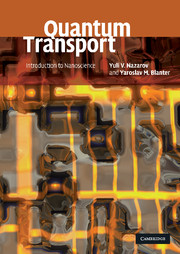Book contents
- Frontmatter
- Contents
- Preface
- Introduction
- 1 Scattering
- 2 Classical and semiclassical transport
- 3 Coulomb blockade
- 4 Randomness and interference
- 5 Qubits and quantum dots
- 6 Interaction, relaxation, and decoherence
- Appendix A Survival kit for advanced quantum mechanics
- Appendix B Survival kit for superconductivity
- Appendix C Unit conversion
- References
- Index
Appendix B - Survival kit for superconductivity
Published online by Cambridge University Press: 05 June 2012
- Frontmatter
- Contents
- Preface
- Introduction
- 1 Scattering
- 2 Classical and semiclassical transport
- 3 Coulomb blockade
- 4 Randomness and interference
- 5 Qubits and quantum dots
- 6 Interaction, relaxation, and decoherence
- Appendix A Survival kit for advanced quantum mechanics
- Appendix B Survival kit for superconductivity
- Appendix C Unit conversion
- References
- Index
Summary
This survival kit is intended to provide basic knowledge of superconductivity necessary for understanding the material of the book. We recommend Refs. [41], [56], and [183] to the reader who wishes to acquire a deeper understanding of superconductivity concepts.
Basic facts
Below a certain temperature Tc (the superconducting transition temperature), the electrical resistance of some metals vanishes. In particular, the most commonly used superconductors are aluminum and niobium; alkali, noble, and magnetic metals never become superconducting. The highest transition temperature found among pure metals is about 9K for niobium; among “usual” superconducting compounds it is 39K for magnesium diboride. There are compounds with even higher transition temperatures, of over 100 K, known as high-temperature superconductors. They possess unusual symmetries, which lead to very uncommon physical properties. We do not consider them in this book.
Superconductors are ideal diamagnets: weak magnetic fields do not penetrate the bulk of superconductors (Meissner effect). A high magnetic field destroys superconductivity. This critical field, Hc, can vary from 1G (approximately 10-4 T) for tungsten to 1980G for niobium.
There is a narrow layer at the boundary of the superconductor where an external magnetic field decreases exponentially to zero value in the bulk. The characteristic length of this decay δp, known as the penetration depth, is temperature-dependent and diverges at the transition temperature proportionally to (Tc - T)-12;.
The transition to the superconducting state is a second-order phase transition in zero magnetic field. It may become a first-order phase transition in finite magnetic fields.
[…]
- Type
- Chapter
- Information
- Quantum TransportIntroduction to Nanoscience, pp. 566 - 568Publisher: Cambridge University PressPrint publication year: 2009



